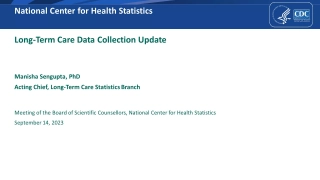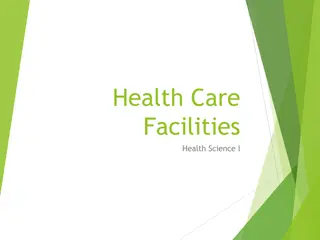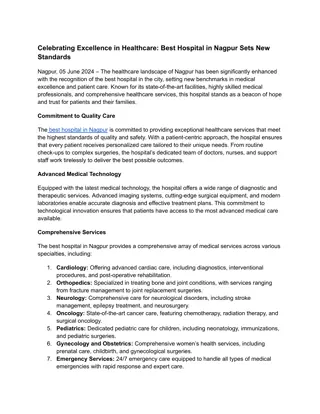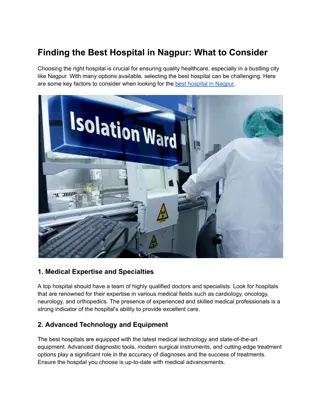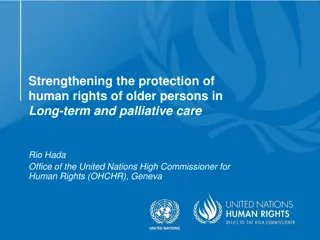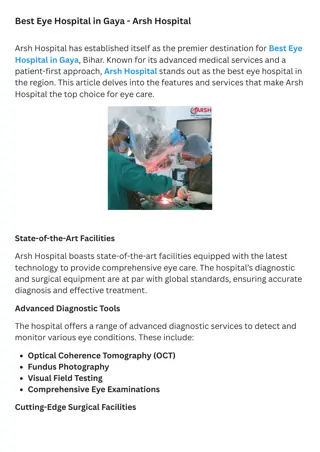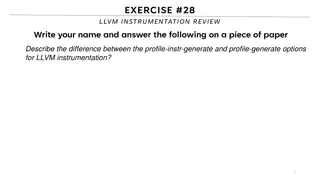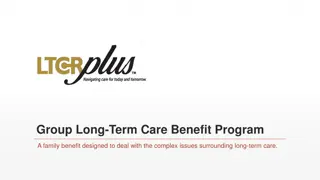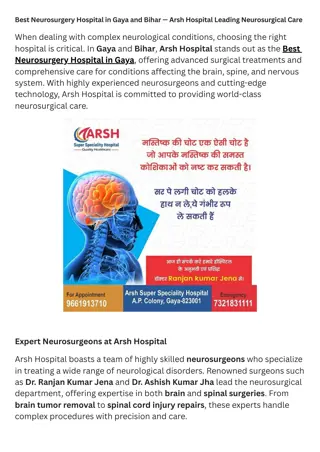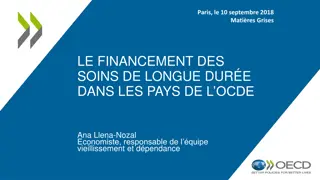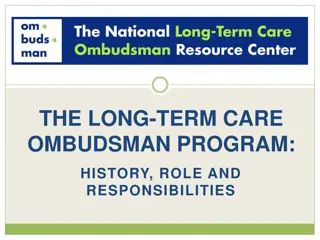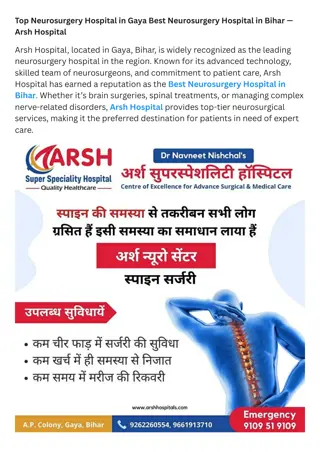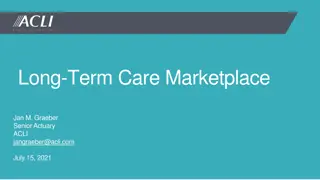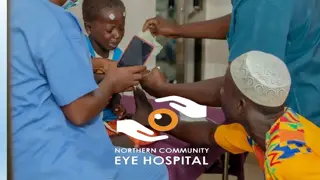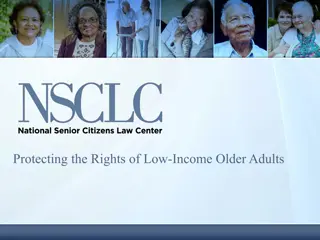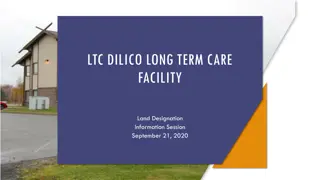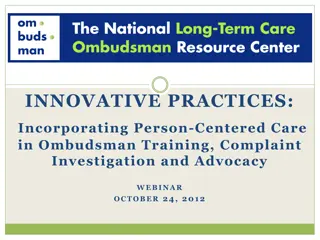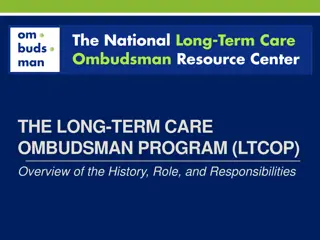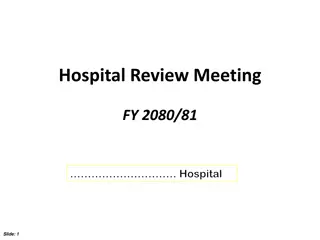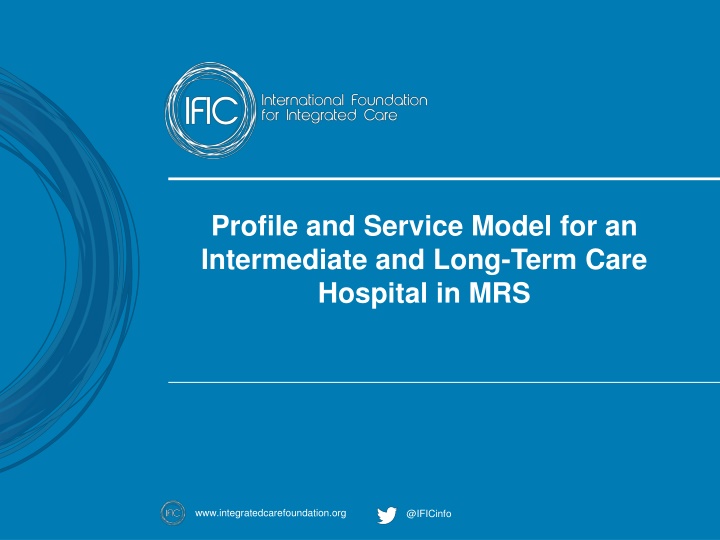
Profile and Service Model for Intermediate and Long-Term Care Hospital
This profile outlines the service model for an Intermediate and Long-Term Care Hospital in MRS, focusing on addressing the needs of an ageing population with chronic diseases through alternative care approaches. The hospital will offer rehabilitation, palliative, and chronic care in a less intensive setting, aimed at maximizing independence and managing future cost burdens through integrated health service delivery networks.
Download Presentation

Please find below an Image/Link to download the presentation.
The content on the website is provided AS IS for your information and personal use only. It may not be sold, licensed, or shared on other websites without obtaining consent from the author. If you encounter any issues during the download, it is possible that the publisher has removed the file from their server.
You are allowed to download the files provided on this website for personal or commercial use, subject to the condition that they are used lawfully. All files are the property of their respective owners.
The content on the website is provided AS IS for your information and personal use only. It may not be sold, licensed, or shared on other websites without obtaining consent from the author.
E N D
Presentation Transcript
Profile and Service Model for an Intermediate and Long-Term Care Hospital in MRS www.integratedcarefoundation.org @IFICinfo A movement for change
Background IDB commissioned the International Foundation for Integrated Care (IFIC) to provide consulting services to advise on the profile and service model for a closed door Intermediate and Long-Term Care Hospital on the Hospital Geral Menandro de Faria (HGMF) site. This re-profiled HGMF will complement the proposed new open door Metropolitan Hospital of around 350 beds that will be built approximately five kilometres from the site of HGMF. Both developments are part of the PROSUS project to transform healthcare through promotion of universal health coverage, development of multi-disciplinary primary health care teams and specialist consultation, diagnostic and treatment centres, and better management of care within and between services using a model based on integrated health service delivery networks. A movement for change
MRS Context Driven by an ageing population and the associated increase in the number of people living with chronic disease in MRS, there is a need to develop alternative approaches to care to help address increasing demand and the future cost burden. In the current system in MRS up to 25% of acute hospital inpatients would be more appropriately managed with rehabilitation, palliative or long term chronic care in a less intensive setting. A movement for change
MRS HOSPITAIS ESTRATGICOS . HGC HS NEW HOSPITAL HGMF HGRS HGESF HGE A movement for change
What are Intermediate Care Services? British Geriatrics Society 2008 Services targeted at people who would otherwise face unnecessarily prolonged hospital stays or inappropriate admission to acute care, long-term residential care, or continuing inpatient care. Services provided on the basis of a comprehensive assessment, resulting in a structured individual care plan that involves active therapy, treatment and opportunity for recovery. Services which have a planned outcome of maximising independence and enabling patients/users to resume living at home. Services which are time limited. Services which involve cross-professional working, with a single assessment framework, single care records and shared protocols. A movement for change
High Performing Intermediate Care Schemes Clear, agreed scope, focused on prevention, rehabilitation, re- ablement and recovery; Time limited, linking and complementing existing services Accessible, flexible and responsive through a single point of access, 7 days a week, and 24 hours a day Based on holistic assessment to maximise independence, confidence and personal outcomes sought by the individual Co-ordinated, able to draw on multi-professional and multi- agency skills and resources as required to meet complex needs Managed for improvement, gathering information on the impact of interventions and using this to inform service improvement. Creating support for self-care to enable prevention, rehabilitation, re-ablement and recovery and so avoid the need for future hospital admissions Focusing on those at risk of emergency admission, or re- admission, to hospital, or to avoid premature permanent admission to a care home - with the potential to regain confidence and independence A movement for change
Anticipated Benefits for MRS from an Intermediate and Long term Care Facility STRATEGIC FIT Stronger interface between primary care and municipality services Hospital operates as part of a community network for chronic disease EFFICIENCY Reduced fragmentation and duplication of post-acute care provision Optimal skill mix across disciplines PRODUCTIVITY MRS acute hospitals have more capacity for complex / intensive care VALUE Increased cost-effectiveness of the whole healthcare system Hospital is a demonstrator for spread of the model within MRS network SUSTAINABILITY Greater resilience and flow across the MRS system COLLABORATION Coordinated interdisciplinary care, rehabilitation and enablement TIMELINESS More prevention, anticipatory care and timely recovery of independence SAFETY Reduced overcrowding and associated risk of hospital acquired infections Early intervention to reduce harm and to avoid readmissions PERSON- CENTREDNESS High quality palliative and end of life care Improved experience and wellbeing at transition between care settings Comprehensive assessment, care planning and interventions to improve function and prevent or delay escalation of dependency EFFECTIVENESS Additional MRS Reference site for education and training of healthcare professionals in intermediate, chronic and palliative care. Spread of competencies across disciplines and across the system EXCELLENCE A movement for change
Options considered Option 1: To re-profile the existing HGMF facility for low intensity, nurse led long - term care. Option 2: To redevelop the existing HGMF facility to provide interdisciplinary rehabilitation and support services and re-provide the inpatient intermediate and long-term care beds in a fit for purpose new building on the same campus. Option 3: This comprises Option 2 as above plus the development of the redesigned campus as an integrated care hub for intermediate and long- term care in collaboration with the network of care providers in Lauro de Freitas and north Salvador districts. A movement for change
Hospital as part of a Network Co-location, coordination, collaboration Community Healthcare Hub o Beds for Intermediate and long-term care o Expert advice on ageing and palliative care o Integrated with Hospital at Home outreach o Telehealthcare capability o Collaboration with local Primary Care teams o Good links with local UPAs and Polyclinics A movement for change
Example from Barcelona A movement for change
Option Appraisal OPTION 2 OPTION 3 OPTION 1 PRINCIPLE CRITERIA STRATEGIC FIT Strengthens primary care and care coordination for chronic disease EFFICIENCY Reduces fragmentation and duplication of post acute provision PRODUCTIVITY Releases capacity within acute hospitals for more complex and intensive care processes Increases cost-effectiveness of the whole healthcare ecosystem VALUE SUSTAINABILITY Builds system resilience and flow COLLABORATION Promotes interdisciplinary care, rehabilitation and enablement TIMELINESS Prevention, anticipatory care and timely recovery of independence SAFETY Early intervention to reduce harm and avoid readmission PERSON CENTRED High quality palliative and end of life care or improved experience at times of transition in care Comprehensive assessment and care planning for geriatric syndromes EFFECTIVENESS EXCELLENCE Reference site for education and training of healthcare professionals FEASIBILITY Can be implemented within 12 months RISK Complex planning, funding and workforce redesign A movement for change
Four Main Patient Profiles 1. 2. 3. 4. Post-acute medical or surgical patients (step down care) Frail / progressively disabled (predominantly older) patients Step-up intermediate care patients Advanced chronic disease and palliative care patients Include adults most over 50 years who need inpatient rehabilitation, nursing or palliative care for at least 7 days due to: Vascular disease or other chronic disease with functional impairment; Post-surgery and skin wounds; Orthopaedic conditions and post-trauma; Dementia, delirium and geriatric syndromes Exclude patients for inpatient haemodialysis, surgery and ICU A movement for change
Demand Hospital BA (CNES) 15-21 dias 22-28 dias 29 dias e + 1,626 326 593 902 3,447 Total % 0003859 HOSPITAL GERAL ROBERTO SANTOS 0004073 HOSPITAL GERAL ERNESTO SIMOES FILHO 0004294 HOSPITAL GERAL DO ESTADO 6595197 HOSPITAL DO SUBURBIO Total 894 143 296 409 1,993 146 472 592 3,203 4,513 615 1,361 1,903 8,392 22 11.6 11.9 11.7 1,742 A single Intermediate and long-term care facility will not resolve all of the demand from acute care in MRS. Initially target Roberto Santos hospital (closest to the site; highest number of long stay patients; high volume of cancer, diabetes and vascular disease. Following evaluation, consider replicating the facility in South MRS A movement for change
Capacity and ICT Refurbishments to the existing HGMF building should be able to provide a rehabilitation area and support services The rehabilitation service needs to fully integrate with the local Hospital at Home team operating from the campus ICT should enable connections about patients to be shared between acute hospitals and municipality health services. Telehealth and videoconferencing capability for remote decision support can be built into the system to support patient care. A movement for change
Plan to create at least 150 fit for purpose inpatient beds on the HGMF campus Facility bed configuration 2 Numbers of beds within Units Profile 1 & 2 Profile 3 Profile 4 30 20 20 25 20 20 30 A movement for change
Patient Pathway Develop decision support tools with the Regulation centre. Comprehensive Assessment by an interdisciplinary team for physical, functional, psychological and social domains Identify patient goals, preferences and treatment ceilings Anticipate equipment and support required for discharge. Interdisciplinary goals setting and individualized intervention plan Comprehensive Geriatric Assessment Discharge and continuum of care Admission Patient and family centered care A movement for change
Intermediate Care Competencies Medical / advanced practice competencies Comprehensive assessment of mental state, cognitive and functional ability Clinical guidelines for chronic conditions eg diabetes, heart failure, stroke Management of acute and chronic pain, dementia, delirium, frailty Prevention and management of falls Generic skills and competencies all professionals Communication skills Compassion, empathy and respect Clinical reasoning and assessment skills Time/patience and the ability to build a rapport/relationship quickly Awareness of community services Risk assessment/management skills surrounding discharge planning Multidisciplinary team working skills Personal care training skills Moving and handling skills Basic life support skills A movement for change
Opportunity for Excellence in Education and Training.... To develop as a teaching and training facility for MRS State Health Schools; To be a satellite MRS reference centre for inpatient elderly care; To act as a beacon site for integrated practice in rehabilitation, chronic care and palliative care in the Region. To be a demonstrator site to coach systems within Brazil and elsewhere in Latin America To act as a hub for an educational network supported by the Telesaude platform; To be a focal point to engage with WHO Communities of Practice and IFIC Special Interest Groups in promoting Intermediate Care; To support action research and evaluation of the model to inform how to spread the approach within MRS and beyond. A movement for change
MRS HR Management Centre may help develop the workforce profile learning from the Catalan model Workforce table for the new MRS intermediate care facility: ratios (heads) for 1 bed Post-acute Frail and chronic Morning 0,054 0,100 Afternoon 0,050 0,068 Night 0,024 0,039 Morning 0,037 0,119 Afternoon 0,035 0,110 Night 0,024 0,058 Registered Nurse Nurse assistants Registered Nurse Nurse assistants Pysician Physical Therapist Assistant P Therapist Patients transporters Occupational Ther. Speech Thearpist Social worker Psychologist 0,038 0,030 0,007 0,017 0,013 0,003 0,012 0,001 0,000 0,000 0,006 0,017 0,000 0,000 0,000 0,000 0,000 0,000 0,000 0,000 0,000 0,000 0,000 0,000 Pysician Physical Therapist Assistant P Therapist Patients transporters Occupational Ther. Speech Thearpist Social worker Psychologist 0,017 0,030 0,007 0,017 0,013 0,003 0,012 0,001 0,000 0,000 0,006 0,017 0,000 0,000 0,000 0,000 0,000 0,000 0,000 0,000 0,000 0,000 0,000 0,000 Values are expressed as N professional (heads) per bed Values are expressed as N professional (heads) per bed Sub-acute Palliative care A movement for change Morning 0,080 0,137 Afternoon 0,080 0,127 Night 0,048 0,049 Morning 0,065 0,130 Afternoon 0,069 0,101 Night 0,036 0,060 Registered Nurse Nurse assistants Registered Nurse Nurse assistants Pysician Physical Therapist Assistant P Therapist Patients transporters Occupational Ther. Speech Thearpist Social worker Psychologist 0,083 0,030 0,000 0,017 0,013 0,003 0,012 0,000 0,000 0,000 0,000 0,017 0,000 0,000 0,000 0,000 0,000 0,000 0,000 0,000 0,000 0,000 0,000 0,000 Pysician Physical Therapist Assistant P Therapist Patients transporters Occupational Ther. Speech Thearpist Social worker Psychologist 0,055 0,024 0,000 0,017 0,013 0,003 0,012 0,031 0,000 0,000 0,000 0,017 0,000 0,000 0,000 0,000 0,000 0,000 0,000 0,000 0,000 0,000 0,000 0,000 Values are expressed as N professional (heads) per bed Values are expressed as N professional (heads) per bed One on-call physician availablefor the whole facility for every 180 beds
Estimated operating costs B$million Direct patient care Additional running costs Estimate for pharmacy, laboratories etc. 15% Full annual operating costs Estimate for management and administration Estimate for cleaning, catering, laundry etc 10% Total Base configuration 105 beds 3.15 0.32 0.47 0.32 1.11 4.26 Larger configuration partially implemented - 135 beds 3.98 0.32 0.6 0.4 1.32 5.30 Larger configuration full implementati on 165 beds 4.76 0.32 0.71 0.48 1.51 6.27 A movement for change
Average Costs per bed per day Estimate for new intermediate and long-term care facility B$ 111 Clinica Medica 453 Clinica Cirurgica Geral 442 Clinica pediatrica Clinica Ortopedia 409 795 Leita/DIA INPC/IBGE mai/ 16 A movement for change
Quality Indicators Case mix age, gender and main diagnoses Activity throughput and activity by professional disciplines Patient outcomes discharge destination and function Clinical Quality Indicators eg falls; pressure ulcers; hospital associated infections; readmissions Efficiency - occupancy, length of stay, delays in discharge Value for money cost per case and by ward Experience of care from questionnaire / follow up visit A movement for change
Managing Change Maximum benefit is likely to be achieved by creating an integrated care facility that operates as a community hub within the local healthcare network Top-down or mandated change is unlikely to succeed unless there is both a compelling case for change, with a clear vision for the future, a guiding coalition of key partners who work together to achieve common objectives. The design elements of the intermediate and long-term care hospital and its associated facilities must be developed alongside policies to engage partners and so promote shared understanding, capacity to collaborate, and successfully implement the new model of care. A movement for change
Detailed Technical Annexes Annex 1 Consultancy Team and visits Annex 2 Evidence for Intermediate Care Annex 3 Decision support tools Annex 4 Bed capacity modelling Annex 5 Physical Design Annex 6 ICT pathways Annex 7 Workforce models Annex 8 Operating costs Annex 9 Competency Frameworks Annex 10 Quality Indicators A movement for change

